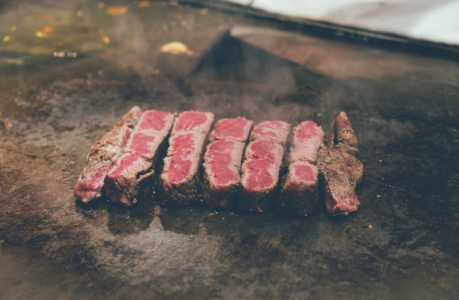Experts reveal the key difference between rare steak and rare chicken
- Replies 0
Food preferences can differ drastically from person to person, especially when the conversation turns to meat and how it’s prepared at the table.
Some people savor the tenderness of a medium-rare steak, while others won’t even consider beef unless it is cooked all the way through to well done.
But when it comes to chicken, the rule shifts from personal preference to universal standard—it must always be cooked completely, and experts explain that the reason has less to do with taste and more to do with science and safety.
The key distinction lies in the structure of the meat itself. Beef steaks are single cuts of dense muscle, which means any harmful bacteria is generally limited to the surface of the meat.
When the steak is seared, those surface bacteria are destroyed, making the inside safe to eat even if it remains pink.
This is why enjoying beef rare or medium rare does not typically carry major health risks when prepared correctly.

Chicken, however, is a very different story. According to the Centers for Disease Control and Prevention (CDC), raw chicken is often contaminated with bacteria such as Salmonella, Campylobacter, or Clostridium perfringens.
Because poultry meat is less dense, bacteria on the surface can penetrate into the interior, meaning that undercooking fails to kill all of the pathogens.
This makes eating rare or pink chicken unsafe and a leading cause of foodborne illness. The CDC estimates that about one in 25 packages of chicken in US grocery stores is contaminated with Salmonella.
“If you eat undercooked chicken, you can get a foodborne illness, also called food poisoning,” the agency explains.
Symptoms can include diarrhea, cramps, fever, nausea, vomiting, chills, headaches, and even blood in the stool.
While most cases resolve within a week, severe illness may require medical care, particularly if dehydration or high fever occurs.
To reduce risk, the CDC recommends storing chicken on the bottom shelf of the refrigerator, washing hands thoroughly for at least 20 seconds after handling, and cooking poultry until it reaches an internal temperature of 165 degrees Fahrenheit.
Unlike beef, there is no safe shortcut when preparing chicken—cooking it through is the only way to ensure harmful bacteria are eliminated.
The difference highlights why food safety rules vary by meat type, even when both are popular sources of protein.
Read next:

Do you prefer your steak rare, medium, or well-done—and did you already know why chicken has to be cooked differently? Share your thoughts in the comments.
Some people savor the tenderness of a medium-rare steak, while others won’t even consider beef unless it is cooked all the way through to well done.
But when it comes to chicken, the rule shifts from personal preference to universal standard—it must always be cooked completely, and experts explain that the reason has less to do with taste and more to do with science and safety.
The key distinction lies in the structure of the meat itself. Beef steaks are single cuts of dense muscle, which means any harmful bacteria is generally limited to the surface of the meat.
When the steak is seared, those surface bacteria are destroyed, making the inside safe to eat even if it remains pink.
This is why enjoying beef rare or medium rare does not typically carry major health risks when prepared correctly.

Experts reveal the key difference between rare steak and rare chicken. Image source: note thanun / Unsplash
Chicken, however, is a very different story. According to the Centers for Disease Control and Prevention (CDC), raw chicken is often contaminated with bacteria such as Salmonella, Campylobacter, or Clostridium perfringens.
Because poultry meat is less dense, bacteria on the surface can penetrate into the interior, meaning that undercooking fails to kill all of the pathogens.
This makes eating rare or pink chicken unsafe and a leading cause of foodborne illness. The CDC estimates that about one in 25 packages of chicken in US grocery stores is contaminated with Salmonella.
“If you eat undercooked chicken, you can get a foodborne illness, also called food poisoning,” the agency explains.
Symptoms can include diarrhea, cramps, fever, nausea, vomiting, chills, headaches, and even blood in the stool.
While most cases resolve within a week, severe illness may require medical care, particularly if dehydration or high fever occurs.
To reduce risk, the CDC recommends storing chicken on the bottom shelf of the refrigerator, washing hands thoroughly for at least 20 seconds after handling, and cooking poultry until it reaches an internal temperature of 165 degrees Fahrenheit.
Unlike beef, there is no safe shortcut when preparing chicken—cooking it through is the only way to ensure harmful bacteria are eliminated.
The difference highlights why food safety rules vary by meat type, even when both are popular sources of protein.
Read next:
- Is your stomach trying to tell you something? Hidden signs you might have food poisoning
- One small change could support your liver—and experts say it’s worth it
Key Takeaways
- Beef steaks can be safely eaten rare because bacteria remain on the surface and are destroyed during searing.
- Chicken is more porous, allowing bacteria like Salmonella to spread throughout the meat, making undercooking unsafe.
- The CDC estimates around one in 25 chicken packages carries Salmonella, a leading cause of food poisoning.
- Cooking chicken to 165°F and practicing safe food handling are essential to preventing illness.






